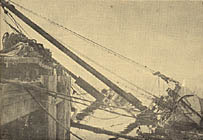The Journal of San Diego History
SAN DIEGO HISTORICAL SOCIETY QUARTERLY
October 1960, Volume 6, Number 4
Jerry MacMullen, Editor
By Bill Virden
 La Jollans have long been used to dense foggy nights; however, prior to November 22, 1915, they had not had occasion to accustom themselves to the moaning of steamer whistles, particularly at 3:15 in the morning and more particularly when the whistle gave every indication that the steamer was plowing along La Jolla Boulevard.
La Jollans have long been used to dense foggy nights; however, prior to November 22, 1915, they had not had occasion to accustom themselves to the moaning of steamer whistles, particularly at 3:15 in the morning and more particularly when the whistle gave every indication that the steamer was plowing along La Jolla Boulevard.
This particular one, the steam schooner Noyo, was southbound from Mendocino with a full load of railroad ties for the Santa Fe railway, which were to be unloaded at San Diego. As a result of having been carried inshore by an unusually strong current, she blundered through a 200-foot gap in the kelp beds off La Jolla, said to have been at that time the only opening between Oceanside and Point Loma, and hit the rocks. The ship was not equipped with wireless, and it was so foggy that neither rockets nor flares would have been effective. The only way to summon help was to cut loose with the whistle, and on the orders of the master of the vessel, Captain Victor Jacobson, this plan was immediately put into effect, probably under the supervision of the captain’s brother, First Mate Oscar Jacobson, who was on watch at the time.
This was more than the population could stand. Having been rudely awakened, they headed for the cliffs, most of them in nighties and bath-robes. Included, rumor hath it, was a bevy of innocent young ladies from the nearby Bishop’s School.
The Noyo, on her uncharted and unscheduled detour, did not come through unscathed. She had knocked a hole in her bottom and was leaking badly. Soon the water got up to her furnaces and put out the fire, which had a disastrous effect on the whistle; it stopped – no steam.
Meanwhile, from the “bleachers” on shore some enterprising individual cupped his hands to his mouth, megaphone-wise, and called out into the fog: “Is there something wrong?” This, apparently, was more than the Captain could stand. Back from the ship, via a real megaphone, came a rich Scandinavian voice: “Iss dere annyting wrong? You (censored) stupid (censored), vy you tink ve are blowing de veestle?” As if by evaporation, the contingent from Bishop’s School disappeared, shooed back home by a scandalized teacher.
Fearing that the ship might capsize, all hands and the ship’s cat piled into the ship’s boats and pulled away from her, heading for the beach. In due time came the dawn, and the fog thinned a bit. It could then be seen that the Noyo was still intact, and sitting up straight. The crew bent to their stubby oars and rowed back to the cold and forlorn Noyo where they clambered aboard, cat and all.
Help was on its way. Word had got to San Diego, and Captain Joe Brennan, later our Port Director, was on his way to La Jolla, in command of the steam tug Babada. Aside from the ties which had gone adrift – and there were a lot of them all over the ocean – the cargo was intact. This, plus her wooden hull, gave her enough buoyancy so that she floated off on the next tide. At six o’clock that night the Babada towed her into San Diego Bay, with only her masts, funnel, upper deckhouse and the tip of her fo’csl showing. They berthed her at the old McCormick Wharf at the foot of Twenty-second street.
The following day they started taking out the ties, and she promptly rolled over. She would have gone all the way, save for the fact that her masts brought her up against the wharf and there she lay, at about a 45 degree angle. In the meantime the Star and Crescent Boat Company sent boats out to La Jolla and they managed to salvage about 700 ties. It might be safe to assume that some of the more diligent coast line residents had some good fire wood-compliments of the Santa Fe Railroad.
Rather than say good-bye to the Noyo in such an undignified and wretched state of leaning against the wharf, we might add that divers patched up the hole in her hull; she was pumped out and they towed her to San Francisco for repairs.
The Noyo was a wooden steamer of 316 gross tons, 150 feet long, and was built by Alexander Hay, of San Francisco, in 1887. She was owned by the Union Lumber Company.







